Conestoga College: MGMT8110 Essay on NAFTA and TPP Trade Agreements
VerifiedAdded on 2022/10/12
|14
|3816
|163
Essay
AI Summary
This essay examines the North American Free Trade Agreement (NAFTA) and the Trans-Pacific Partnership (TPP), two major international trade agreements. It begins by outlining the purpose of NAFTA, which aimed to boost economic activity among the US, Canada, and Mexico by eliminating tariffs. The essay then explores the TPP, a US-led initiative intended to enhance trade and investment in the Asia-Pacific region before the US withdrawal. The discussion section delves into the replacement of NAFTA with the USMCA agreement and provides an overview of the economic impacts and debates surrounding NAFTA, including job relocation and economic growth. The essay also details the structure and provisions of the TPP, including tariff reductions, service trade liberalization, investment rules, and e-commerce guidelines. It highlights the TPP's goals of creating an integrated economic region and establishing consistent global trade rules, while also addressing the agreement's impact on intellectual property, labor standards, and environmental protections. The essay concludes by discussing the potential economic and geopolitical benefits of the TPP, as well as criticisms from various stakeholders. The essay provides an overview of the complex landscape of international trade agreements and their implications for global economies.
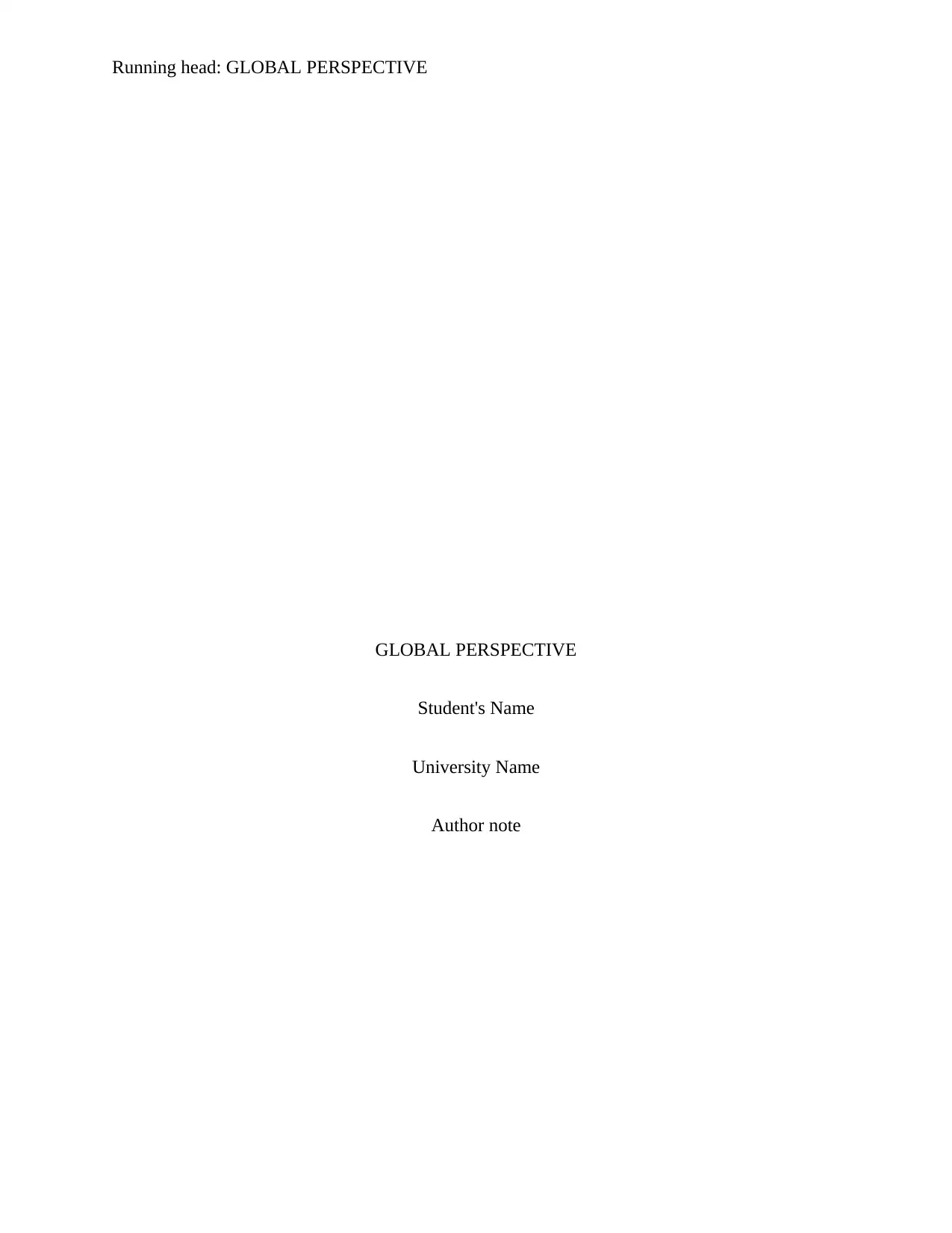
Running head: GLOBAL PERSPECTIVE
GLOBAL PERSPECTIVE
Student's Name
University Name
Author note
GLOBAL PERSPECTIVE
Student's Name
University Name
Author note
Paraphrase This Document
Need a fresh take? Get an instant paraphrase of this document with our AI Paraphraser
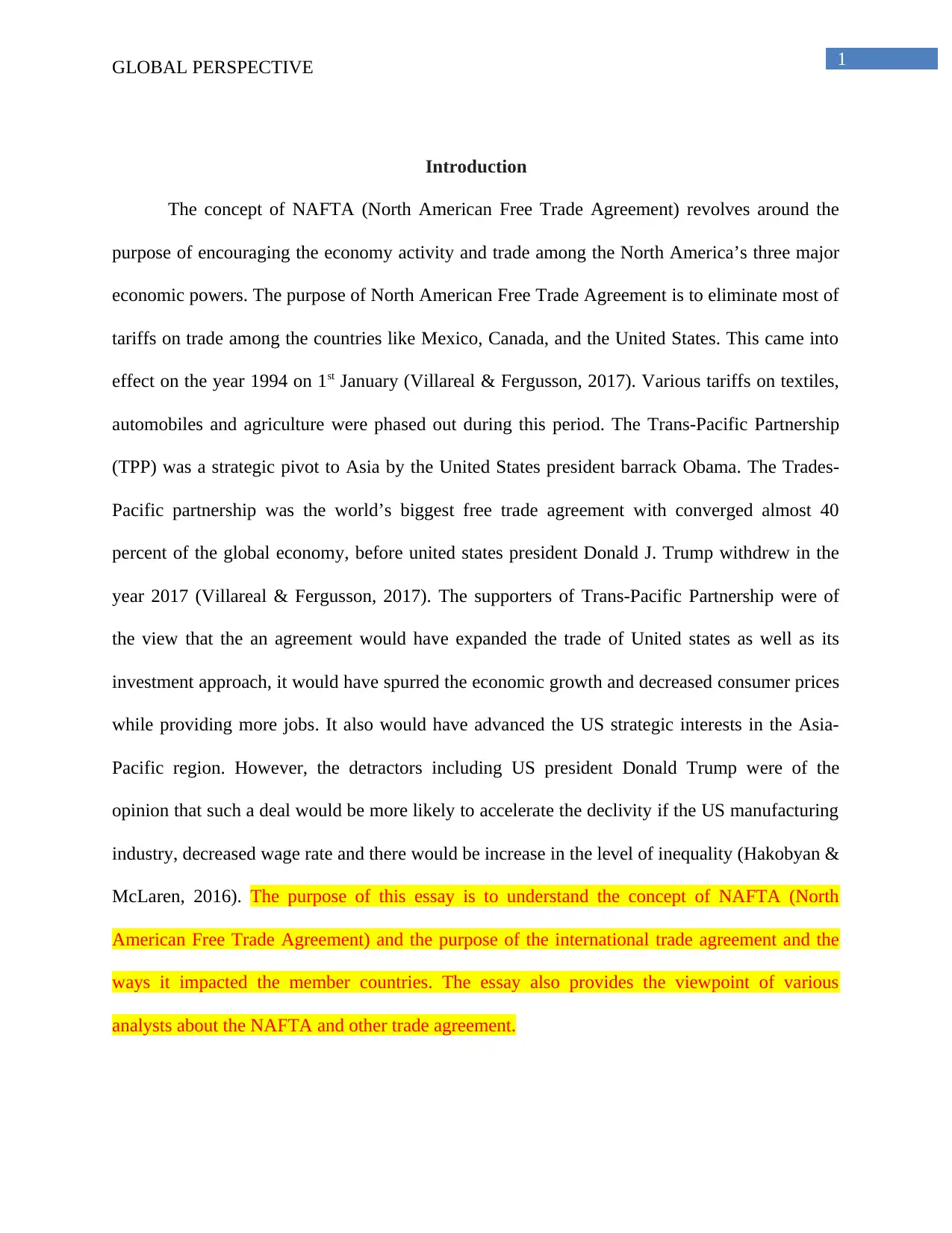
1GLOBAL PERSPECTIVE
Introduction
The concept of NAFTA (North American Free Trade Agreement) revolves around the
purpose of encouraging the economy activity and trade among the North America’s three major
economic powers. The purpose of North American Free Trade Agreement is to eliminate most of
tariffs on trade among the countries like Mexico, Canada, and the United States. This came into
effect on the year 1994 on 1st January (Villareal & Fergusson, 2017). Various tariffs on textiles,
automobiles and agriculture were phased out during this period. The Trans-Pacific Partnership
(TPP) was a strategic pivot to Asia by the United States president barrack Obama. The Trades-
Pacific partnership was the world’s biggest free trade agreement with converged almost 40
percent of the global economy, before united states president Donald J. Trump withdrew in the
year 2017 (Villareal & Fergusson, 2017). The supporters of Trans-Pacific Partnership were of
the view that the an agreement would have expanded the trade of United states as well as its
investment approach, it would have spurred the economic growth and decreased consumer prices
while providing more jobs. It also would have advanced the US strategic interests in the Asia-
Pacific region. However, the detractors including US president Donald Trump were of the
opinion that such a deal would be more likely to accelerate the declivity if the US manufacturing
industry, decreased wage rate and there would be increase in the level of inequality (Hakobyan &
McLaren, 2016). The purpose of this essay is to understand the concept of NAFTA (North
American Free Trade Agreement) and the purpose of the international trade agreement and the
ways it impacted the member countries. The essay also provides the viewpoint of various
analysts about the NAFTA and other trade agreement.
Introduction
The concept of NAFTA (North American Free Trade Agreement) revolves around the
purpose of encouraging the economy activity and trade among the North America’s three major
economic powers. The purpose of North American Free Trade Agreement is to eliminate most of
tariffs on trade among the countries like Mexico, Canada, and the United States. This came into
effect on the year 1994 on 1st January (Villareal & Fergusson, 2017). Various tariffs on textiles,
automobiles and agriculture were phased out during this period. The Trans-Pacific Partnership
(TPP) was a strategic pivot to Asia by the United States president barrack Obama. The Trades-
Pacific partnership was the world’s biggest free trade agreement with converged almost 40
percent of the global economy, before united states president Donald J. Trump withdrew in the
year 2017 (Villareal & Fergusson, 2017). The supporters of Trans-Pacific Partnership were of
the view that the an agreement would have expanded the trade of United states as well as its
investment approach, it would have spurred the economic growth and decreased consumer prices
while providing more jobs. It also would have advanced the US strategic interests in the Asia-
Pacific region. However, the detractors including US president Donald Trump were of the
opinion that such a deal would be more likely to accelerate the declivity if the US manufacturing
industry, decreased wage rate and there would be increase in the level of inequality (Hakobyan &
McLaren, 2016). The purpose of this essay is to understand the concept of NAFTA (North
American Free Trade Agreement) and the purpose of the international trade agreement and the
ways it impacted the member countries. The essay also provides the viewpoint of various
analysts about the NAFTA and other trade agreement.

2GLOBAL PERSPECTIVE
Discussion
According to McKinney, (2016), it was campaigned on a promise to repeal NAFTA by
the president of the United States Donald Trump along with the other international trade
agreement which he considered to be unfair to the country. the NAFTA (North American Free
Trade Agreement) was replaced with the Mexico Trade Agreement which was a new trade deal
with the Mexico and it would maintain a tariff free access to the agricultural commodities on
either side of the border and it would eliminate all forms of non tariff barriers while encouraging
more agricultural trade between the United states and Mexico in the year 2018, August 27th
(Hakobyan & McLaren, 2016). In the year 2019, September 30th, the United States signed an
agreement with Canada in order to replace NAFTA (North American Free Trade Agreement)
which was termed USMCA- the United states-Mexico-Canada agreement. It was done in the
presence of the Canada trade offices and the representatives. It was a high standard trade
agreement which gives the workers, farmers, business and ranchers’ freer markers and a more
fair trade among the countries (McKinney, 2016). This will ensure a robust economic growth in
the United States. This will enable surer opportunities for half of the population and create better
paying jobs.
It was mentioned by Lahrech & Sylwester, (2013), Canada and Mexico is the second and
the third largest suppliers of imported goods. Around one-fourth of all the US imports including
machinery, gold, processed foods, fresh produce, livestock, and crude oil are originated from
Mexico and Canada. Additionally, there are around one-third of the exports of United States such
as parts of vehicles; minerals, oil, plastics, fuels and machinery are destined for Mexico and
Canada. The legislation was developed by President George H.W. Bush in the belief that it
would create many new jobs within the two years and 1 million within the next five years
Discussion
According to McKinney, (2016), it was campaigned on a promise to repeal NAFTA by
the president of the United States Donald Trump along with the other international trade
agreement which he considered to be unfair to the country. the NAFTA (North American Free
Trade Agreement) was replaced with the Mexico Trade Agreement which was a new trade deal
with the Mexico and it would maintain a tariff free access to the agricultural commodities on
either side of the border and it would eliminate all forms of non tariff barriers while encouraging
more agricultural trade between the United states and Mexico in the year 2018, August 27th
(Hakobyan & McLaren, 2016). In the year 2019, September 30th, the United States signed an
agreement with Canada in order to replace NAFTA (North American Free Trade Agreement)
which was termed USMCA- the United states-Mexico-Canada agreement. It was done in the
presence of the Canada trade offices and the representatives. It was a high standard trade
agreement which gives the workers, farmers, business and ranchers’ freer markers and a more
fair trade among the countries (McKinney, 2016). This will ensure a robust economic growth in
the United States. This will enable surer opportunities for half of the population and create better
paying jobs.
It was mentioned by Lahrech & Sylwester, (2013), Canada and Mexico is the second and
the third largest suppliers of imported goods. Around one-fourth of all the US imports including
machinery, gold, processed foods, fresh produce, livestock, and crude oil are originated from
Mexico and Canada. Additionally, there are around one-third of the exports of United States such
as parts of vehicles; minerals, oil, plastics, fuels and machinery are destined for Mexico and
Canada. The legislation was developed by President George H.W. Bush in the belief that it
would create many new jobs within the two years and 1 million within the next five years
⊘ This is a preview!⊘
Do you want full access?
Subscribe today to unlock all pages.

Trusted by 1+ million students worldwide
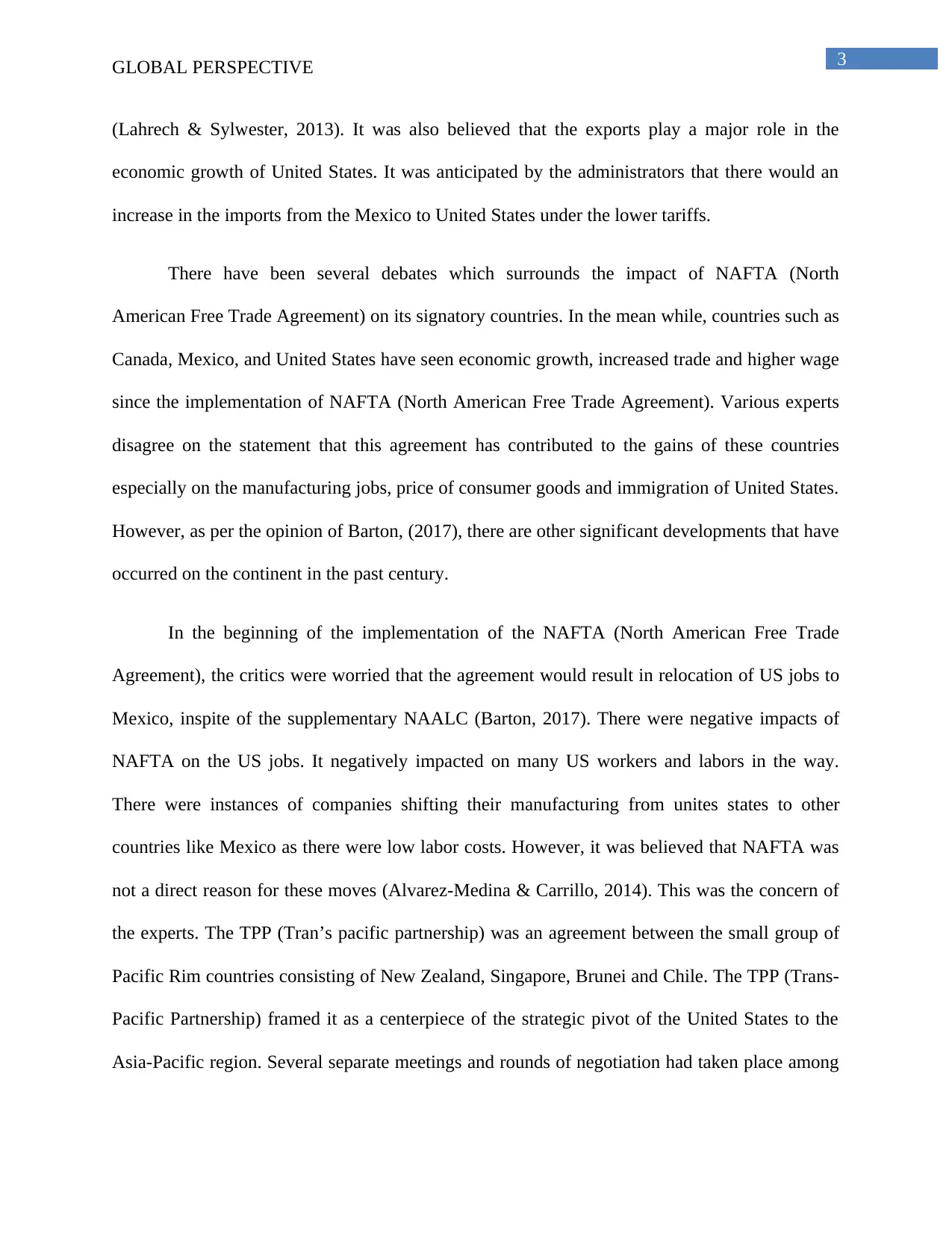
3GLOBAL PERSPECTIVE
(Lahrech & Sylwester, 2013). It was also believed that the exports play a major role in the
economic growth of United States. It was anticipated by the administrators that there would an
increase in the imports from the Mexico to United States under the lower tariffs.
There have been several debates which surrounds the impact of NAFTA (North
American Free Trade Agreement) on its signatory countries. In the mean while, countries such as
Canada, Mexico, and United States have seen economic growth, increased trade and higher wage
since the implementation of NAFTA (North American Free Trade Agreement). Various experts
disagree on the statement that this agreement has contributed to the gains of these countries
especially on the manufacturing jobs, price of consumer goods and immigration of United States.
However, as per the opinion of Barton, (2017), there are other significant developments that have
occurred on the continent in the past century.
In the beginning of the implementation of the NAFTA (North American Free Trade
Agreement), the critics were worried that the agreement would result in relocation of US jobs to
Mexico, inspite of the supplementary NAALC (Barton, 2017). There were negative impacts of
NAFTA on the US jobs. It negatively impacted on many US workers and labors in the way.
There were instances of companies shifting their manufacturing from unites states to other
countries like Mexico as there were low labor costs. However, it was believed that NAFTA was
not a direct reason for these moves (Alvarez-Medina & Carrillo, 2014). This was the concern of
the experts. The TPP (Tran’s pacific partnership) was an agreement between the small group of
Pacific Rim countries consisting of New Zealand, Singapore, Brunei and Chile. The TPP (Trans-
Pacific Partnership) framed it as a centerpiece of the strategic pivot of the United States to the
Asia-Pacific region. Several separate meetings and rounds of negotiation had taken place among
(Lahrech & Sylwester, 2013). It was also believed that the exports play a major role in the
economic growth of United States. It was anticipated by the administrators that there would an
increase in the imports from the Mexico to United States under the lower tariffs.
There have been several debates which surrounds the impact of NAFTA (North
American Free Trade Agreement) on its signatory countries. In the mean while, countries such as
Canada, Mexico, and United States have seen economic growth, increased trade and higher wage
since the implementation of NAFTA (North American Free Trade Agreement). Various experts
disagree on the statement that this agreement has contributed to the gains of these countries
especially on the manufacturing jobs, price of consumer goods and immigration of United States.
However, as per the opinion of Barton, (2017), there are other significant developments that have
occurred on the continent in the past century.
In the beginning of the implementation of the NAFTA (North American Free Trade
Agreement), the critics were worried that the agreement would result in relocation of US jobs to
Mexico, inspite of the supplementary NAALC (Barton, 2017). There were negative impacts of
NAFTA on the US jobs. It negatively impacted on many US workers and labors in the way.
There were instances of companies shifting their manufacturing from unites states to other
countries like Mexico as there were low labor costs. However, it was believed that NAFTA was
not a direct reason for these moves (Alvarez-Medina & Carrillo, 2014). This was the concern of
the experts. The TPP (Tran’s pacific partnership) was an agreement between the small group of
Pacific Rim countries consisting of New Zealand, Singapore, Brunei and Chile. The TPP (Trans-
Pacific Partnership) framed it as a centerpiece of the strategic pivot of the United States to the
Asia-Pacific region. Several separate meetings and rounds of negotiation had taken place among
Paraphrase This Document
Need a fresh take? Get an instant paraphrase of this document with our AI Paraphraser
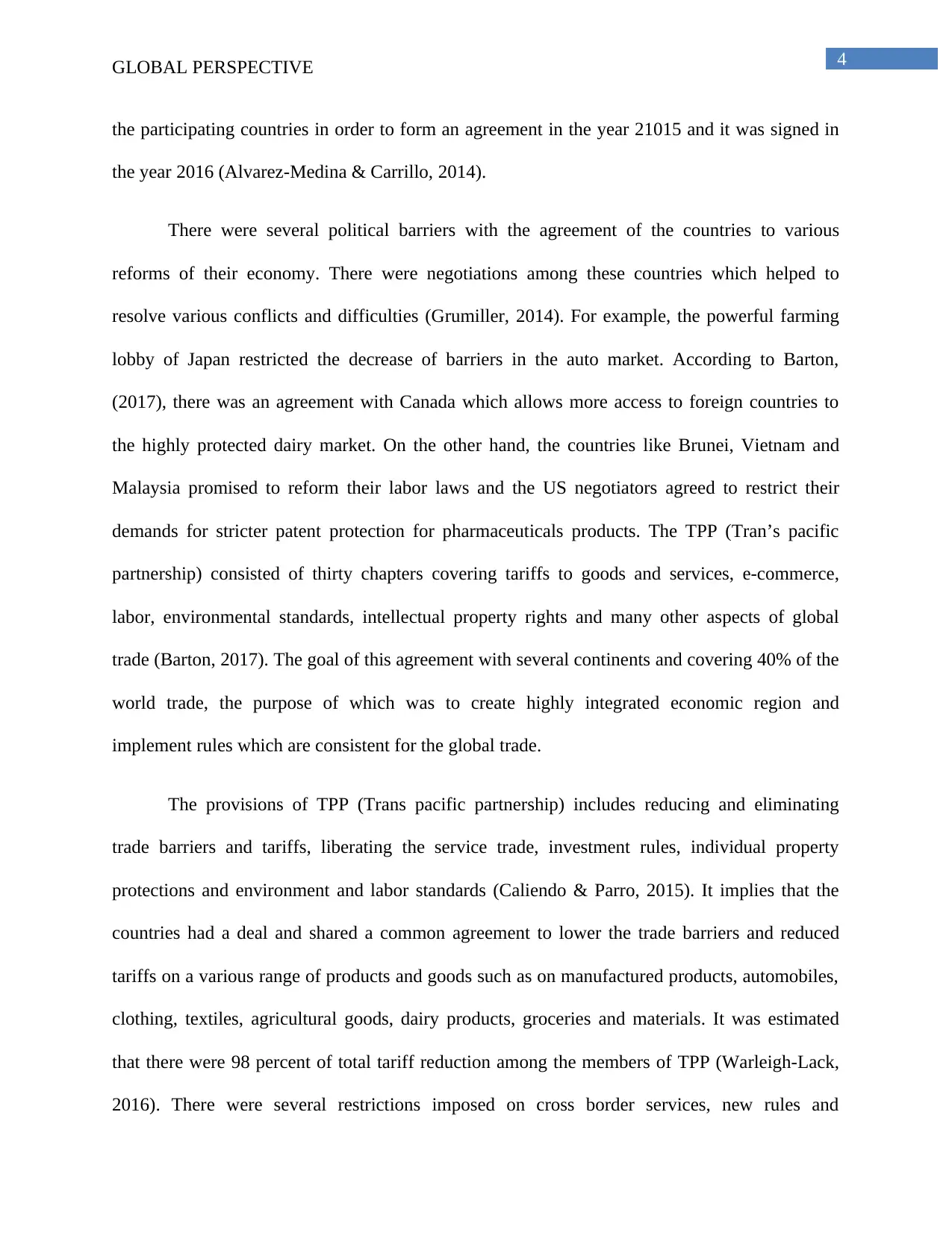
4GLOBAL PERSPECTIVE
the participating countries in order to form an agreement in the year 21015 and it was signed in
the year 2016 (Alvarez-Medina & Carrillo, 2014).
There were several political barriers with the agreement of the countries to various
reforms of their economy. There were negotiations among these countries which helped to
resolve various conflicts and difficulties (Grumiller, 2014). For example, the powerful farming
lobby of Japan restricted the decrease of barriers in the auto market. According to Barton,
(2017), there was an agreement with Canada which allows more access to foreign countries to
the highly protected dairy market. On the other hand, the countries like Brunei, Vietnam and
Malaysia promised to reform their labor laws and the US negotiators agreed to restrict their
demands for stricter patent protection for pharmaceuticals products. The TPP (Tran’s pacific
partnership) consisted of thirty chapters covering tariffs to goods and services, e-commerce,
labor, environmental standards, intellectual property rights and many other aspects of global
trade (Barton, 2017). The goal of this agreement with several continents and covering 40% of the
world trade, the purpose of which was to create highly integrated economic region and
implement rules which are consistent for the global trade.
The provisions of TPP (Trans pacific partnership) includes reducing and eliminating
trade barriers and tariffs, liberating the service trade, investment rules, individual property
protections and environment and labor standards (Caliendo & Parro, 2015). It implies that the
countries had a deal and shared a common agreement to lower the trade barriers and reduced
tariffs on a various range of products and goods such as on manufactured products, automobiles,
clothing, textiles, agricultural goods, dairy products, groceries and materials. It was estimated
that there were 98 percent of total tariff reduction among the members of TPP (Warleigh-Lack,
2016). There were several restrictions imposed on cross border services, new rules and
the participating countries in order to form an agreement in the year 21015 and it was signed in
the year 2016 (Alvarez-Medina & Carrillo, 2014).
There were several political barriers with the agreement of the countries to various
reforms of their economy. There were negotiations among these countries which helped to
resolve various conflicts and difficulties (Grumiller, 2014). For example, the powerful farming
lobby of Japan restricted the decrease of barriers in the auto market. According to Barton,
(2017), there was an agreement with Canada which allows more access to foreign countries to
the highly protected dairy market. On the other hand, the countries like Brunei, Vietnam and
Malaysia promised to reform their labor laws and the US negotiators agreed to restrict their
demands for stricter patent protection for pharmaceuticals products. The TPP (Tran’s pacific
partnership) consisted of thirty chapters covering tariffs to goods and services, e-commerce,
labor, environmental standards, intellectual property rights and many other aspects of global
trade (Barton, 2017). The goal of this agreement with several continents and covering 40% of the
world trade, the purpose of which was to create highly integrated economic region and
implement rules which are consistent for the global trade.
The provisions of TPP (Trans pacific partnership) includes reducing and eliminating
trade barriers and tariffs, liberating the service trade, investment rules, individual property
protections and environment and labor standards (Caliendo & Parro, 2015). It implies that the
countries had a deal and shared a common agreement to lower the trade barriers and reduced
tariffs on a various range of products and goods such as on manufactured products, automobiles,
clothing, textiles, agricultural goods, dairy products, groceries and materials. It was estimated
that there were 98 percent of total tariff reduction among the members of TPP (Warleigh-Lack,
2016). There were several restrictions imposed on cross border services, new rules and
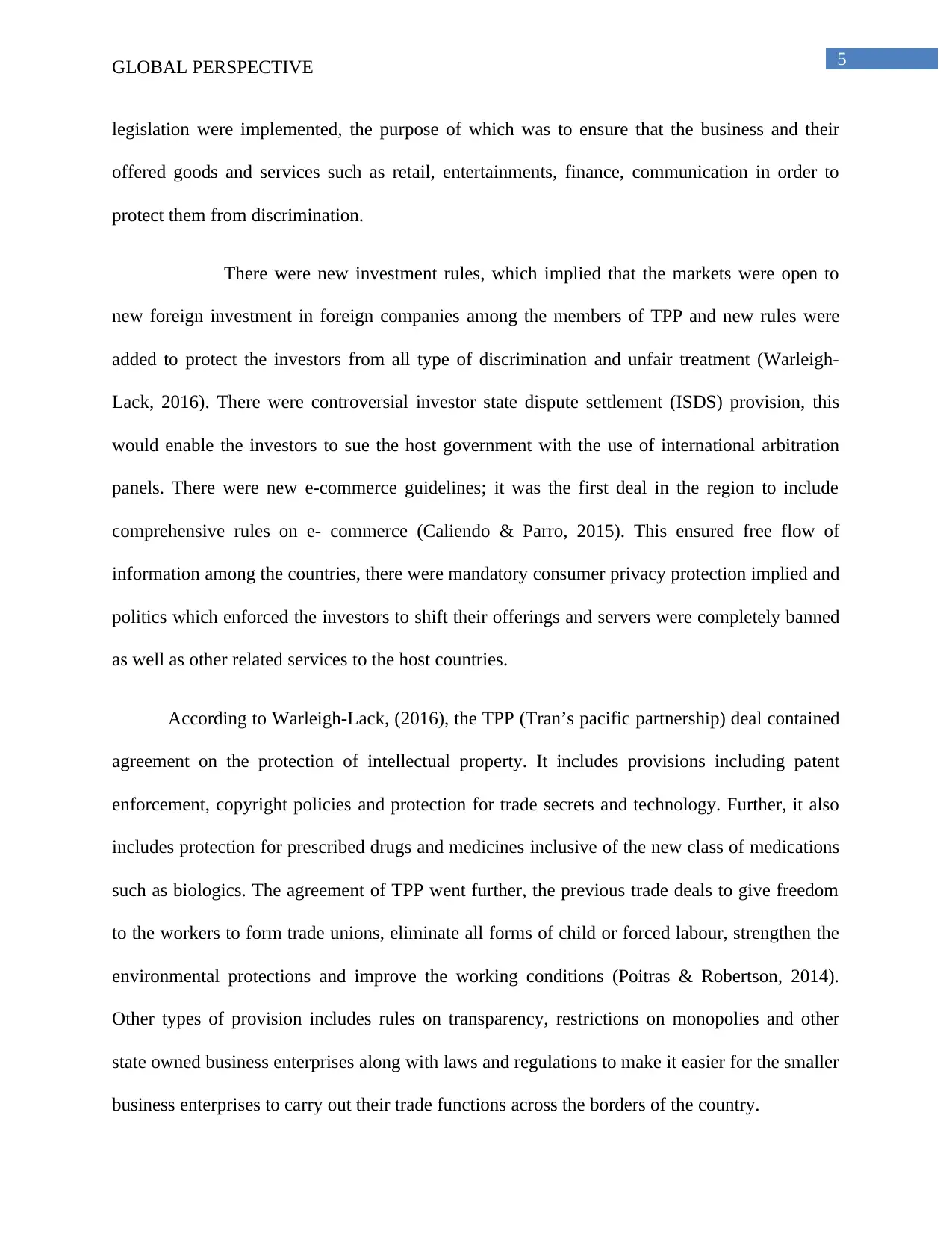
5GLOBAL PERSPECTIVE
legislation were implemented, the purpose of which was to ensure that the business and their
offered goods and services such as retail, entertainments, finance, communication in order to
protect them from discrimination.
There were new investment rules, which implied that the markets were open to
new foreign investment in foreign companies among the members of TPP and new rules were
added to protect the investors from all type of discrimination and unfair treatment (Warleigh-
Lack, 2016). There were controversial investor state dispute settlement (ISDS) provision, this
would enable the investors to sue the host government with the use of international arbitration
panels. There were new e-commerce guidelines; it was the first deal in the region to include
comprehensive rules on e- commerce (Caliendo & Parro, 2015). This ensured free flow of
information among the countries, there were mandatory consumer privacy protection implied and
politics which enforced the investors to shift their offerings and servers were completely banned
as well as other related services to the host countries.
According to Warleigh-Lack, (2016), the TPP (Tran’s pacific partnership) deal contained
agreement on the protection of intellectual property. It includes provisions including patent
enforcement, copyright policies and protection for trade secrets and technology. Further, it also
includes protection for prescribed drugs and medicines inclusive of the new class of medications
such as biologics. The agreement of TPP went further, the previous trade deals to give freedom
to the workers to form trade unions, eliminate all forms of child or forced labour, strengthen the
environmental protections and improve the working conditions (Poitras & Robertson, 2014).
Other types of provision includes rules on transparency, restrictions on monopolies and other
state owned business enterprises along with laws and regulations to make it easier for the smaller
business enterprises to carry out their trade functions across the borders of the country.
legislation were implemented, the purpose of which was to ensure that the business and their
offered goods and services such as retail, entertainments, finance, communication in order to
protect them from discrimination.
There were new investment rules, which implied that the markets were open to
new foreign investment in foreign companies among the members of TPP and new rules were
added to protect the investors from all type of discrimination and unfair treatment (Warleigh-
Lack, 2016). There were controversial investor state dispute settlement (ISDS) provision, this
would enable the investors to sue the host government with the use of international arbitration
panels. There were new e-commerce guidelines; it was the first deal in the region to include
comprehensive rules on e- commerce (Caliendo & Parro, 2015). This ensured free flow of
information among the countries, there were mandatory consumer privacy protection implied and
politics which enforced the investors to shift their offerings and servers were completely banned
as well as other related services to the host countries.
According to Warleigh-Lack, (2016), the TPP (Tran’s pacific partnership) deal contained
agreement on the protection of intellectual property. It includes provisions including patent
enforcement, copyright policies and protection for trade secrets and technology. Further, it also
includes protection for prescribed drugs and medicines inclusive of the new class of medications
such as biologics. The agreement of TPP went further, the previous trade deals to give freedom
to the workers to form trade unions, eliminate all forms of child or forced labour, strengthen the
environmental protections and improve the working conditions (Poitras & Robertson, 2014).
Other types of provision includes rules on transparency, restrictions on monopolies and other
state owned business enterprises along with laws and regulations to make it easier for the smaller
business enterprises to carry out their trade functions across the borders of the country.
⊘ This is a preview!⊘
Do you want full access?
Subscribe today to unlock all pages.

Trusted by 1+ million students worldwide
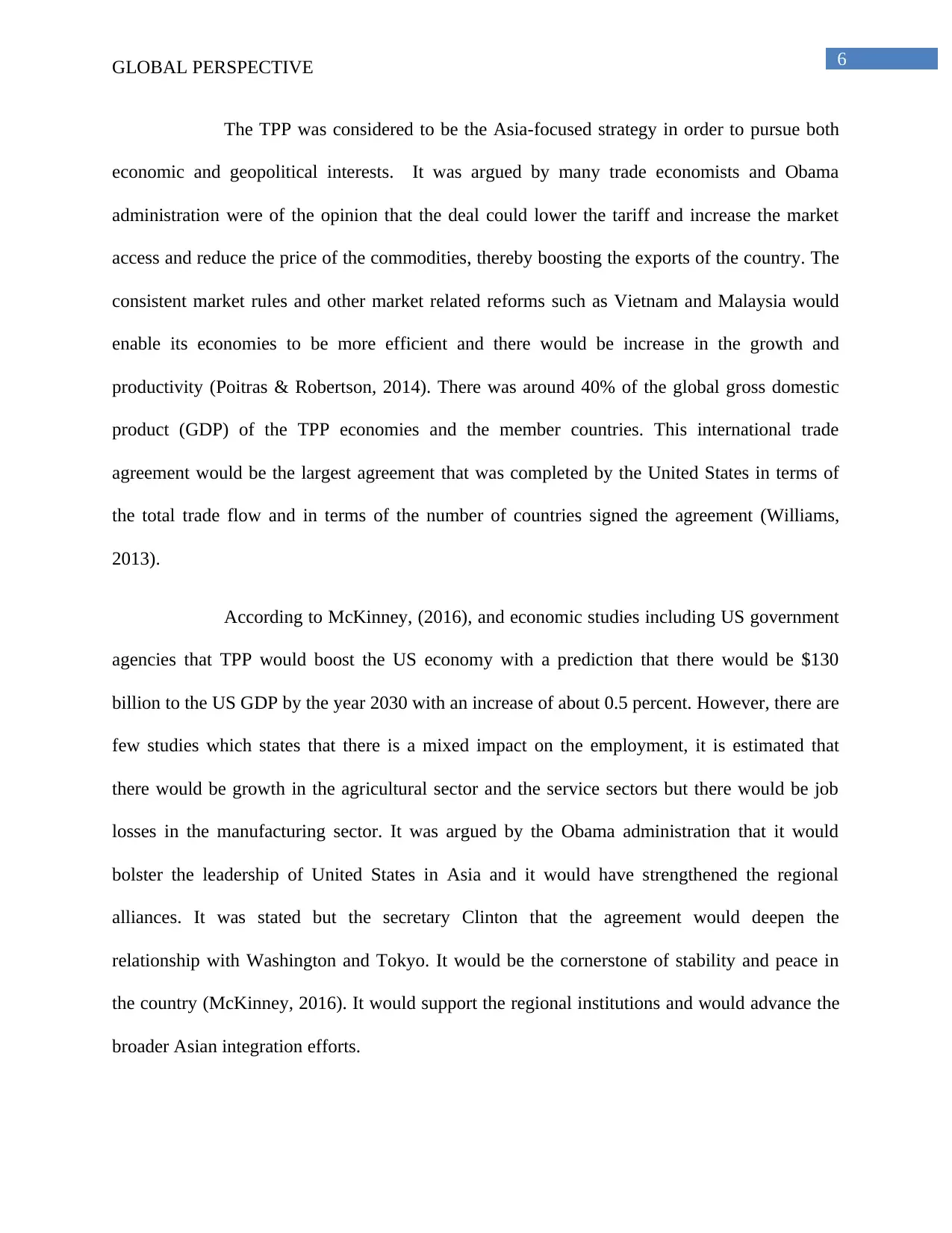
6GLOBAL PERSPECTIVE
The TPP was considered to be the Asia-focused strategy in order to pursue both
economic and geopolitical interests. It was argued by many trade economists and Obama
administration were of the opinion that the deal could lower the tariff and increase the market
access and reduce the price of the commodities, thereby boosting the exports of the country. The
consistent market rules and other market related reforms such as Vietnam and Malaysia would
enable its economies to be more efficient and there would be increase in the growth and
productivity (Poitras & Robertson, 2014). There was around 40% of the global gross domestic
product (GDP) of the TPP economies and the member countries. This international trade
agreement would be the largest agreement that was completed by the United States in terms of
the total trade flow and in terms of the number of countries signed the agreement (Williams,
2013).
According to McKinney, (2016), and economic studies including US government
agencies that TPP would boost the US economy with a prediction that there would be $130
billion to the US GDP by the year 2030 with an increase of about 0.5 percent. However, there are
few studies which states that there is a mixed impact on the employment, it is estimated that
there would be growth in the agricultural sector and the service sectors but there would be job
losses in the manufacturing sector. It was argued by the Obama administration that it would
bolster the leadership of United States in Asia and it would have strengthened the regional
alliances. It was stated but the secretary Clinton that the agreement would deepen the
relationship with Washington and Tokyo. It would be the cornerstone of stability and peace in
the country (McKinney, 2016). It would support the regional institutions and would advance the
broader Asian integration efforts.
The TPP was considered to be the Asia-focused strategy in order to pursue both
economic and geopolitical interests. It was argued by many trade economists and Obama
administration were of the opinion that the deal could lower the tariff and increase the market
access and reduce the price of the commodities, thereby boosting the exports of the country. The
consistent market rules and other market related reforms such as Vietnam and Malaysia would
enable its economies to be more efficient and there would be increase in the growth and
productivity (Poitras & Robertson, 2014). There was around 40% of the global gross domestic
product (GDP) of the TPP economies and the member countries. This international trade
agreement would be the largest agreement that was completed by the United States in terms of
the total trade flow and in terms of the number of countries signed the agreement (Williams,
2013).
According to McKinney, (2016), and economic studies including US government
agencies that TPP would boost the US economy with a prediction that there would be $130
billion to the US GDP by the year 2030 with an increase of about 0.5 percent. However, there are
few studies which states that there is a mixed impact on the employment, it is estimated that
there would be growth in the agricultural sector and the service sectors but there would be job
losses in the manufacturing sector. It was argued by the Obama administration that it would
bolster the leadership of United States in Asia and it would have strengthened the regional
alliances. It was stated but the secretary Clinton that the agreement would deepen the
relationship with Washington and Tokyo. It would be the cornerstone of stability and peace in
the country (McKinney, 2016). It would support the regional institutions and would advance the
broader Asian integration efforts.
Paraphrase This Document
Need a fresh take? Get an instant paraphrase of this document with our AI Paraphraser
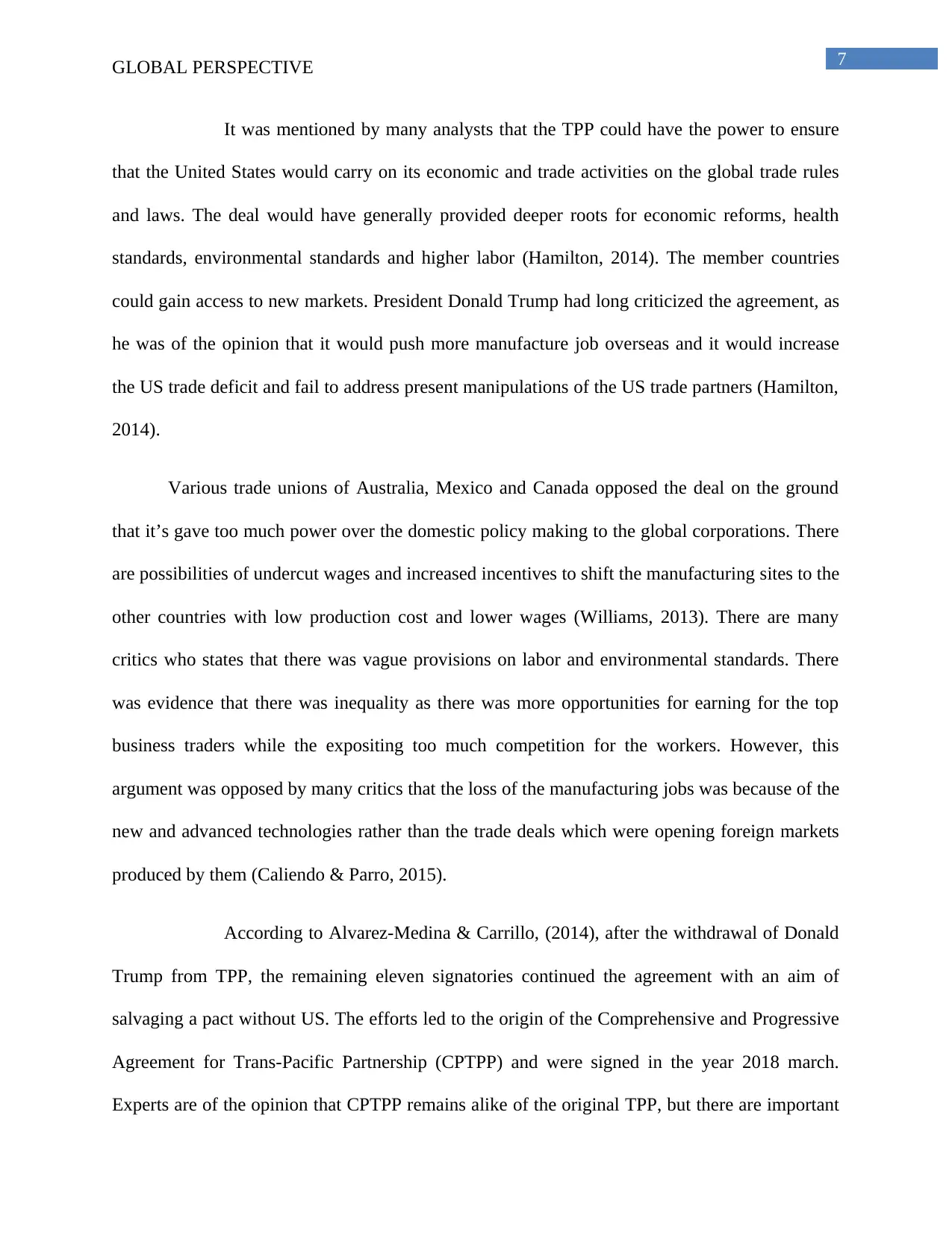
7GLOBAL PERSPECTIVE
It was mentioned by many analysts that the TPP could have the power to ensure
that the United States would carry on its economic and trade activities on the global trade rules
and laws. The deal would have generally provided deeper roots for economic reforms, health
standards, environmental standards and higher labor (Hamilton, 2014). The member countries
could gain access to new markets. President Donald Trump had long criticized the agreement, as
he was of the opinion that it would push more manufacture job overseas and it would increase
the US trade deficit and fail to address present manipulations of the US trade partners (Hamilton,
2014).
Various trade unions of Australia, Mexico and Canada opposed the deal on the ground
that it’s gave too much power over the domestic policy making to the global corporations. There
are possibilities of undercut wages and increased incentives to shift the manufacturing sites to the
other countries with low production cost and lower wages (Williams, 2013). There are many
critics who states that there was vague provisions on labor and environmental standards. There
was evidence that there was inequality as there was more opportunities for earning for the top
business traders while the expositing too much competition for the workers. However, this
argument was opposed by many critics that the loss of the manufacturing jobs was because of the
new and advanced technologies rather than the trade deals which were opening foreign markets
produced by them (Caliendo & Parro, 2015).
According to Alvarez-Medina & Carrillo, (2014), after the withdrawal of Donald
Trump from TPP, the remaining eleven signatories continued the agreement with an aim of
salvaging a pact without US. The efforts led to the origin of the Comprehensive and Progressive
Agreement for Trans-Pacific Partnership (CPTPP) and were signed in the year 2018 march.
Experts are of the opinion that CPTPP remains alike of the original TPP, but there are important
It was mentioned by many analysts that the TPP could have the power to ensure
that the United States would carry on its economic and trade activities on the global trade rules
and laws. The deal would have generally provided deeper roots for economic reforms, health
standards, environmental standards and higher labor (Hamilton, 2014). The member countries
could gain access to new markets. President Donald Trump had long criticized the agreement, as
he was of the opinion that it would push more manufacture job overseas and it would increase
the US trade deficit and fail to address present manipulations of the US trade partners (Hamilton,
2014).
Various trade unions of Australia, Mexico and Canada opposed the deal on the ground
that it’s gave too much power over the domestic policy making to the global corporations. There
are possibilities of undercut wages and increased incentives to shift the manufacturing sites to the
other countries with low production cost and lower wages (Williams, 2013). There are many
critics who states that there was vague provisions on labor and environmental standards. There
was evidence that there was inequality as there was more opportunities for earning for the top
business traders while the expositing too much competition for the workers. However, this
argument was opposed by many critics that the loss of the manufacturing jobs was because of the
new and advanced technologies rather than the trade deals which were opening foreign markets
produced by them (Caliendo & Parro, 2015).
According to Alvarez-Medina & Carrillo, (2014), after the withdrawal of Donald
Trump from TPP, the remaining eleven signatories continued the agreement with an aim of
salvaging a pact without US. The efforts led to the origin of the Comprehensive and Progressive
Agreement for Trans-Pacific Partnership (CPTPP) and were signed in the year 2018 march.
Experts are of the opinion that CPTPP remains alike of the original TPP, but there are important
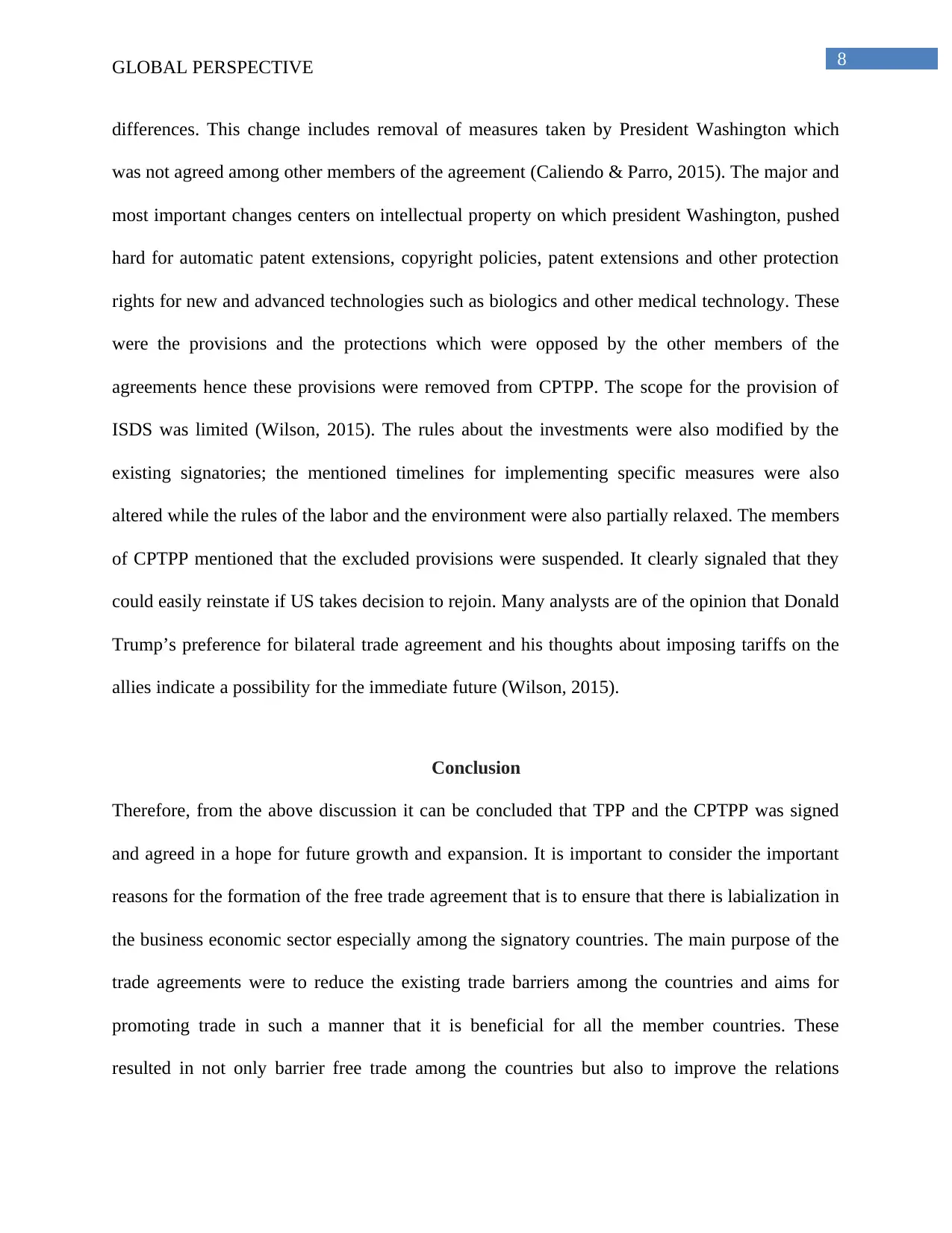
8GLOBAL PERSPECTIVE
differences. This change includes removal of measures taken by President Washington which
was not agreed among other members of the agreement (Caliendo & Parro, 2015). The major and
most important changes centers on intellectual property on which president Washington, pushed
hard for automatic patent extensions, copyright policies, patent extensions and other protection
rights for new and advanced technologies such as biologics and other medical technology. These
were the provisions and the protections which were opposed by the other members of the
agreements hence these provisions were removed from CPTPP. The scope for the provision of
ISDS was limited (Wilson, 2015). The rules about the investments were also modified by the
existing signatories; the mentioned timelines for implementing specific measures were also
altered while the rules of the labor and the environment were also partially relaxed. The members
of CPTPP mentioned that the excluded provisions were suspended. It clearly signaled that they
could easily reinstate if US takes decision to rejoin. Many analysts are of the opinion that Donald
Trump’s preference for bilateral trade agreement and his thoughts about imposing tariffs on the
allies indicate a possibility for the immediate future (Wilson, 2015).
Conclusion
Therefore, from the above discussion it can be concluded that TPP and the CPTPP was signed
and agreed in a hope for future growth and expansion. It is important to consider the important
reasons for the formation of the free trade agreement that is to ensure that there is labialization in
the business economic sector especially among the signatory countries. The main purpose of the
trade agreements were to reduce the existing trade barriers among the countries and aims for
promoting trade in such a manner that it is beneficial for all the member countries. These
resulted in not only barrier free trade among the countries but also to improve the relations
differences. This change includes removal of measures taken by President Washington which
was not agreed among other members of the agreement (Caliendo & Parro, 2015). The major and
most important changes centers on intellectual property on which president Washington, pushed
hard for automatic patent extensions, copyright policies, patent extensions and other protection
rights for new and advanced technologies such as biologics and other medical technology. These
were the provisions and the protections which were opposed by the other members of the
agreements hence these provisions were removed from CPTPP. The scope for the provision of
ISDS was limited (Wilson, 2015). The rules about the investments were also modified by the
existing signatories; the mentioned timelines for implementing specific measures were also
altered while the rules of the labor and the environment were also partially relaxed. The members
of CPTPP mentioned that the excluded provisions were suspended. It clearly signaled that they
could easily reinstate if US takes decision to rejoin. Many analysts are of the opinion that Donald
Trump’s preference for bilateral trade agreement and his thoughts about imposing tariffs on the
allies indicate a possibility for the immediate future (Wilson, 2015).
Conclusion
Therefore, from the above discussion it can be concluded that TPP and the CPTPP was signed
and agreed in a hope for future growth and expansion. It is important to consider the important
reasons for the formation of the free trade agreement that is to ensure that there is labialization in
the business economic sector especially among the signatory countries. The main purpose of the
trade agreements were to reduce the existing trade barriers among the countries and aims for
promoting trade in such a manner that it is beneficial for all the member countries. These
resulted in not only barrier free trade among the countries but also to improve the relations
⊘ This is a preview!⊘
Do you want full access?
Subscribe today to unlock all pages.

Trusted by 1+ million students worldwide
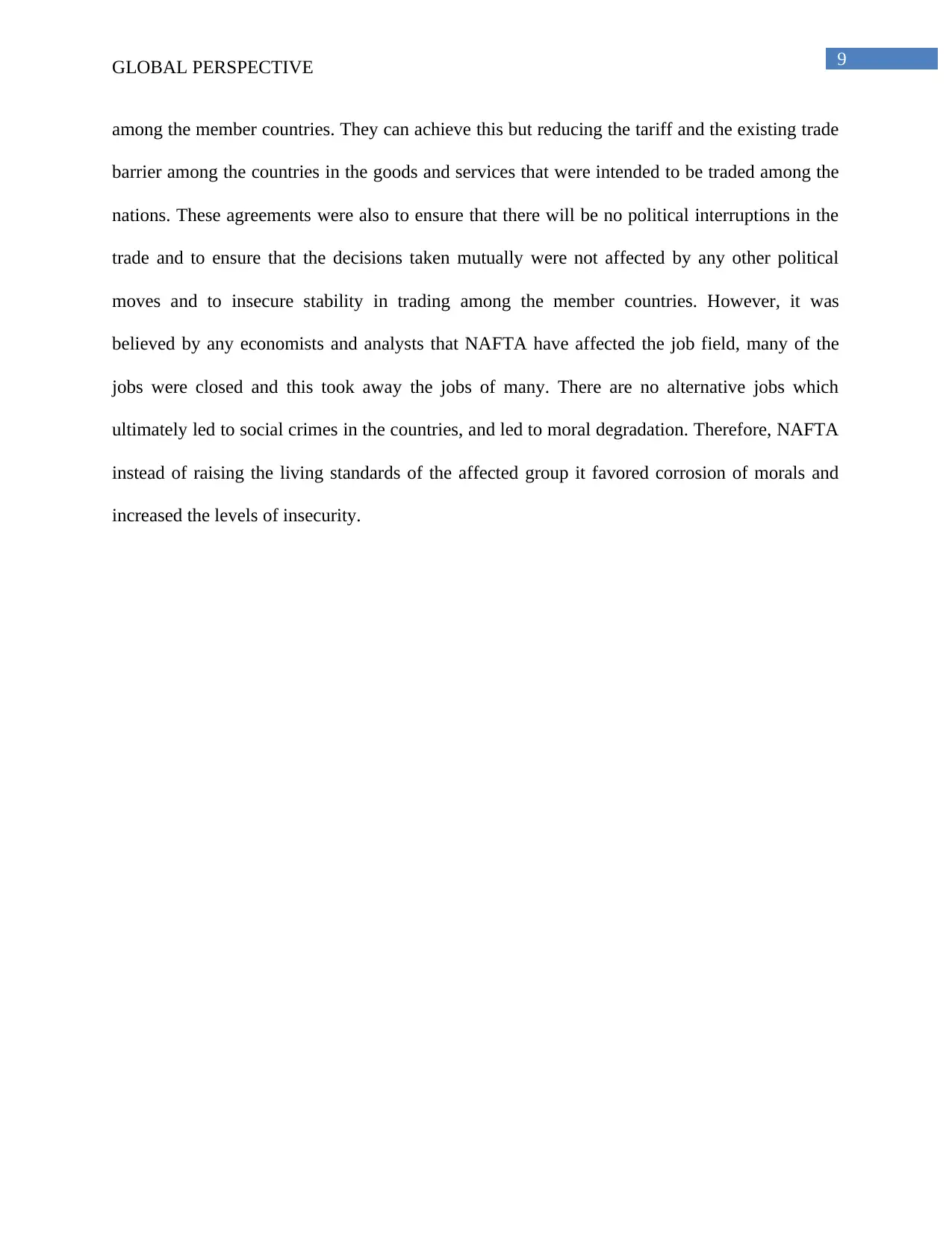
9GLOBAL PERSPECTIVE
among the member countries. They can achieve this but reducing the tariff and the existing trade
barrier among the countries in the goods and services that were intended to be traded among the
nations. These agreements were also to ensure that there will be no political interruptions in the
trade and to ensure that the decisions taken mutually were not affected by any other political
moves and to insecure stability in trading among the member countries. However, it was
believed by any economists and analysts that NAFTA have affected the job field, many of the
jobs were closed and this took away the jobs of many. There are no alternative jobs which
ultimately led to social crimes in the countries, and led to moral degradation. Therefore, NAFTA
instead of raising the living standards of the affected group it favored corrosion of morals and
increased the levels of insecurity.
among the member countries. They can achieve this but reducing the tariff and the existing trade
barrier among the countries in the goods and services that were intended to be traded among the
nations. These agreements were also to ensure that there will be no political interruptions in the
trade and to ensure that the decisions taken mutually were not affected by any other political
moves and to insecure stability in trading among the member countries. However, it was
believed by any economists and analysts that NAFTA have affected the job field, many of the
jobs were closed and this took away the jobs of many. There are no alternative jobs which
ultimately led to social crimes in the countries, and led to moral degradation. Therefore, NAFTA
instead of raising the living standards of the affected group it favored corrosion of morals and
increased the levels of insecurity.
Paraphrase This Document
Need a fresh take? Get an instant paraphrase of this document with our AI Paraphraser
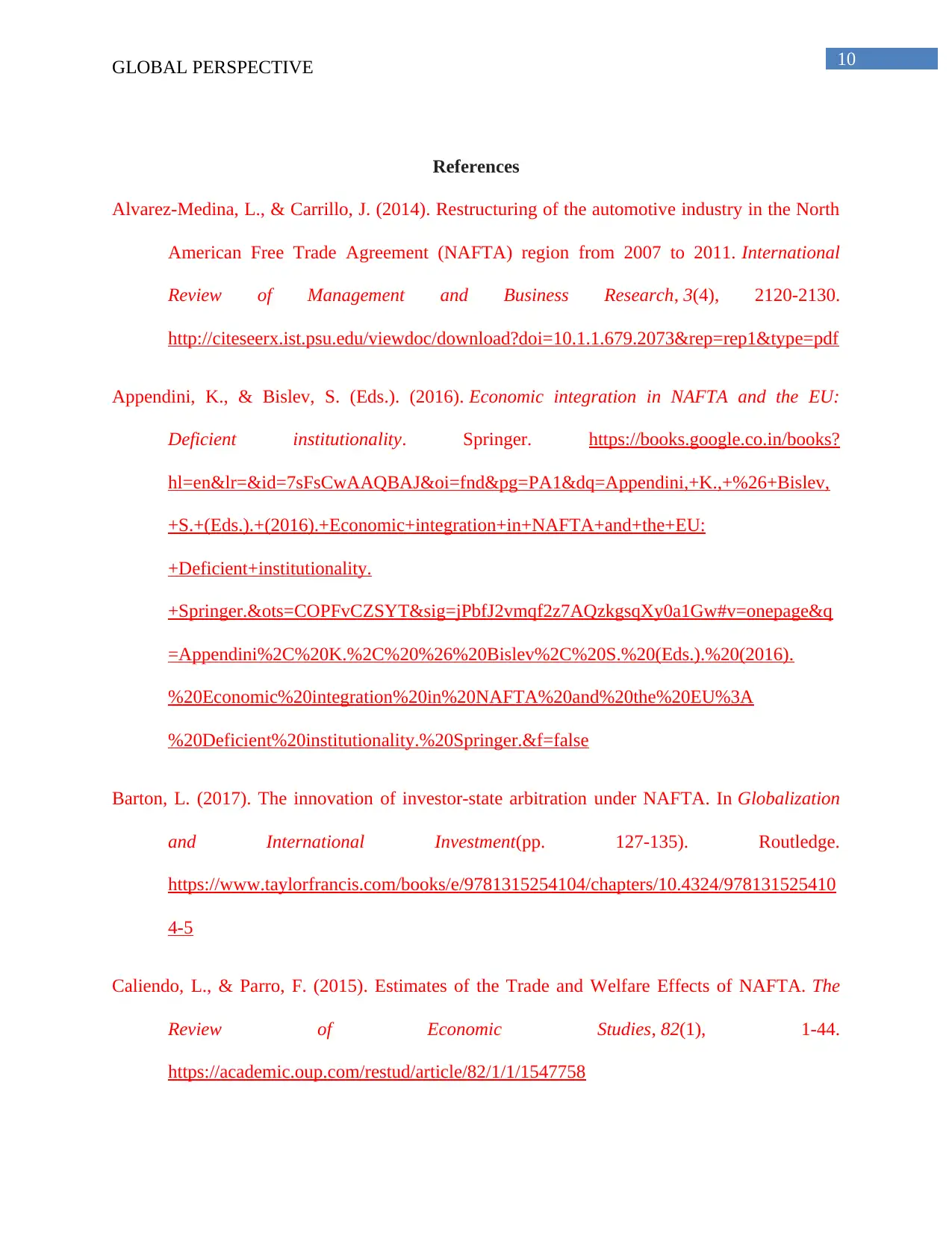
10GLOBAL PERSPECTIVE
References
Alvarez-Medina, L., & Carrillo, J. (2014). Restructuring of the automotive industry in the North
American Free Trade Agreement (NAFTA) region from 2007 to 2011. International
Review of Management and Business Research, 3(4), 2120-2130.
http://citeseerx.ist.psu.edu/viewdoc/download?doi=10.1.1.679.2073&rep=rep1&type=pdf
Appendini, K., & Bislev, S. (Eds.). (2016). Economic integration in NAFTA and the EU:
Deficient institutionality. Springer. https://books.google.co.in/books?
hl=en&lr=&id=7sFsCwAAQBAJ&oi=fnd&pg=PA1&dq=Appendini,+K.,+%26+Bislev,
+S.+(Eds.).+(2016).+Economic+integration+in+NAFTA+and+the+EU:
+Deficient+institutionality.
+Springer.&ots=COPFvCZSYT&sig=jPbfJ2vmqf2z7AQzkgsqXy0a1Gw#v=onepage&q
=Appendini%2C%20K.%2C%20%26%20Bislev%2C%20S.%20(Eds.).%20(2016).
%20Economic%20integration%20in%20NAFTA%20and%20the%20EU%3A
%20Deficient%20institutionality.%20Springer.&f=false
Barton, L. (2017). The innovation of investor-state arbitration under NAFTA. In Globalization
and International Investment(pp. 127-135). Routledge.
https://www.taylorfrancis.com/books/e/9781315254104/chapters/10.4324/978131525410
4-5
Caliendo, L., & Parro, F. (2015). Estimates of the Trade and Welfare Effects of NAFTA. The
Review of Economic Studies, 82(1), 1-44.
https://academic.oup.com/restud/article/82/1/1/1547758
References
Alvarez-Medina, L., & Carrillo, J. (2014). Restructuring of the automotive industry in the North
American Free Trade Agreement (NAFTA) region from 2007 to 2011. International
Review of Management and Business Research, 3(4), 2120-2130.
http://citeseerx.ist.psu.edu/viewdoc/download?doi=10.1.1.679.2073&rep=rep1&type=pdf
Appendini, K., & Bislev, S. (Eds.). (2016). Economic integration in NAFTA and the EU:
Deficient institutionality. Springer. https://books.google.co.in/books?
hl=en&lr=&id=7sFsCwAAQBAJ&oi=fnd&pg=PA1&dq=Appendini,+K.,+%26+Bislev,
+S.+(Eds.).+(2016).+Economic+integration+in+NAFTA+and+the+EU:
+Deficient+institutionality.
+Springer.&ots=COPFvCZSYT&sig=jPbfJ2vmqf2z7AQzkgsqXy0a1Gw#v=onepage&q
=Appendini%2C%20K.%2C%20%26%20Bislev%2C%20S.%20(Eds.).%20(2016).
%20Economic%20integration%20in%20NAFTA%20and%20the%20EU%3A
%20Deficient%20institutionality.%20Springer.&f=false
Barton, L. (2017). The innovation of investor-state arbitration under NAFTA. In Globalization
and International Investment(pp. 127-135). Routledge.
https://www.taylorfrancis.com/books/e/9781315254104/chapters/10.4324/978131525410
4-5
Caliendo, L., & Parro, F. (2015). Estimates of the Trade and Welfare Effects of NAFTA. The
Review of Economic Studies, 82(1), 1-44.
https://academic.oup.com/restud/article/82/1/1/1547758
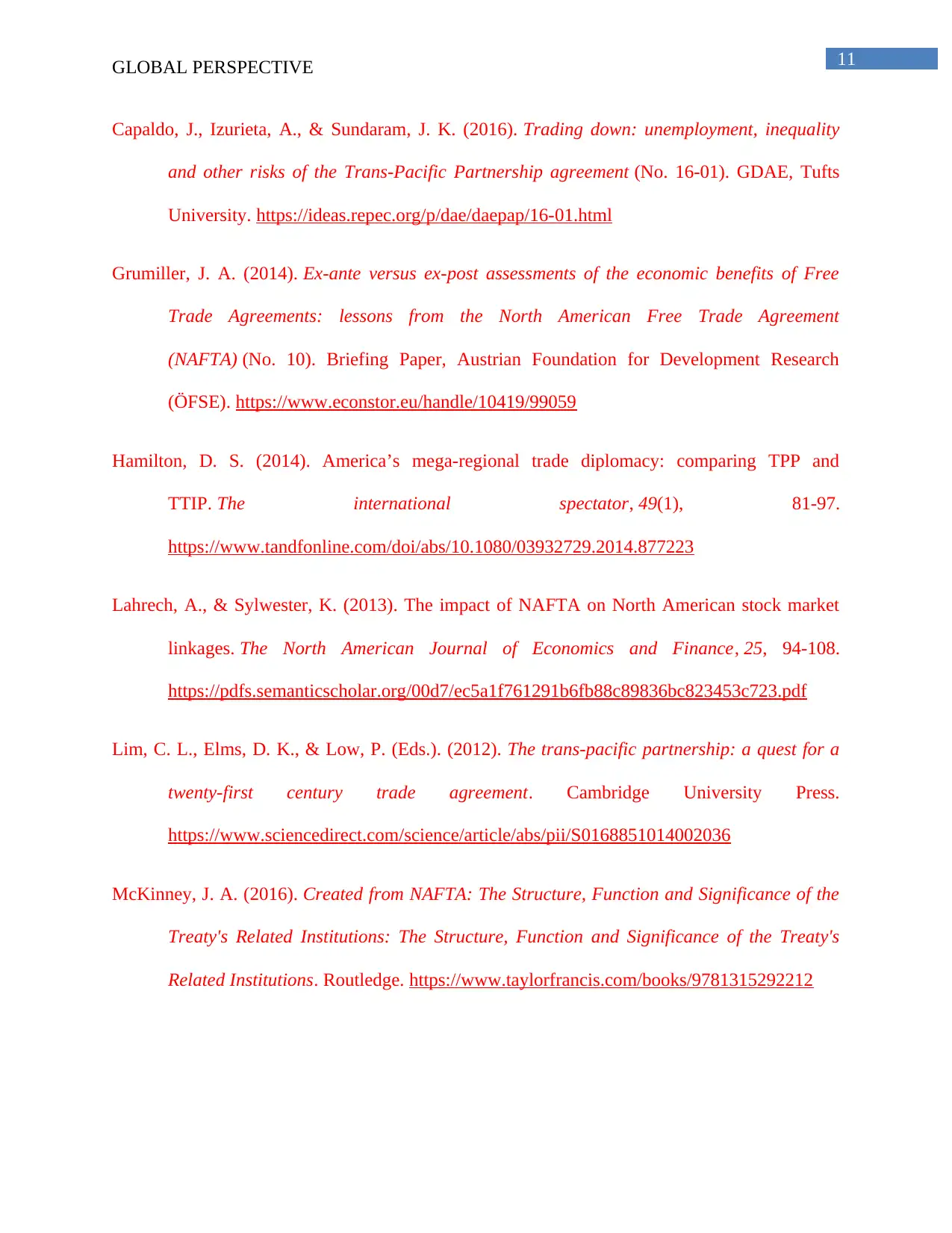
11GLOBAL PERSPECTIVE
Capaldo, J., Izurieta, A., & Sundaram, J. K. (2016). Trading down: unemployment, inequality
and other risks of the Trans-Pacific Partnership agreement (No. 16-01). GDAE, Tufts
University. https://ideas.repec.org/p/dae/daepap/16-01.html
Grumiller, J. A. (2014). Ex-ante versus ex-post assessments of the economic benefits of Free
Trade Agreements: lessons from the North American Free Trade Agreement
(NAFTA) (No. 10). Briefing Paper, Austrian Foundation for Development Research
(ÖFSE). https://www.econstor.eu/handle/10419/99059
Hamilton, D. S. (2014). America’s mega-regional trade diplomacy: comparing TPP and
TTIP. The international spectator, 49(1), 81-97.
https://www.tandfonline.com/doi/abs/10.1080/03932729.2014.877223
Lahrech, A., & Sylwester, K. (2013). The impact of NAFTA on North American stock market
linkages. The North American Journal of Economics and Finance, 25, 94-108.
https://pdfs.semanticscholar.org/00d7/ec5a1f761291b6fb88c89836bc823453c723.pdf
Lim, C. L., Elms, D. K., & Low, P. (Eds.). (2012). The trans-pacific partnership: a quest for a
twenty-first century trade agreement. Cambridge University Press.
https://www.sciencedirect.com/science/article/abs/pii/S0168851014002036
McKinney, J. A. (2016). Created from NAFTA: The Structure, Function and Significance of the
Treaty's Related Institutions: The Structure, Function and Significance of the Treaty's
Related Institutions. Routledge. https://www.taylorfrancis.com/books/9781315292212
Capaldo, J., Izurieta, A., & Sundaram, J. K. (2016). Trading down: unemployment, inequality
and other risks of the Trans-Pacific Partnership agreement (No. 16-01). GDAE, Tufts
University. https://ideas.repec.org/p/dae/daepap/16-01.html
Grumiller, J. A. (2014). Ex-ante versus ex-post assessments of the economic benefits of Free
Trade Agreements: lessons from the North American Free Trade Agreement
(NAFTA) (No. 10). Briefing Paper, Austrian Foundation for Development Research
(ÖFSE). https://www.econstor.eu/handle/10419/99059
Hamilton, D. S. (2014). America’s mega-regional trade diplomacy: comparing TPP and
TTIP. The international spectator, 49(1), 81-97.
https://www.tandfonline.com/doi/abs/10.1080/03932729.2014.877223
Lahrech, A., & Sylwester, K. (2013). The impact of NAFTA on North American stock market
linkages. The North American Journal of Economics and Finance, 25, 94-108.
https://pdfs.semanticscholar.org/00d7/ec5a1f761291b6fb88c89836bc823453c723.pdf
Lim, C. L., Elms, D. K., & Low, P. (Eds.). (2012). The trans-pacific partnership: a quest for a
twenty-first century trade agreement. Cambridge University Press.
https://www.sciencedirect.com/science/article/abs/pii/S0168851014002036
McKinney, J. A. (2016). Created from NAFTA: The Structure, Function and Significance of the
Treaty's Related Institutions: The Structure, Function and Significance of the Treaty's
Related Institutions. Routledge. https://www.taylorfrancis.com/books/9781315292212
⊘ This is a preview!⊘
Do you want full access?
Subscribe today to unlock all pages.

Trusted by 1+ million students worldwide
1 out of 14
Related Documents
Your All-in-One AI-Powered Toolkit for Academic Success.
+13062052269
info@desklib.com
Available 24*7 on WhatsApp / Email
![[object Object]](/_next/static/media/star-bottom.7253800d.svg)
Unlock your academic potential
Copyright © 2020–2025 A2Z Services. All Rights Reserved. Developed and managed by ZUCOL.



